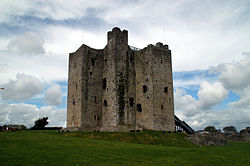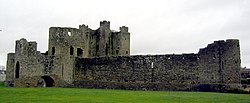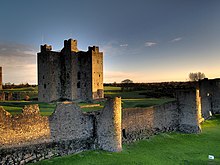Trim Castle: Difference between revisions
Tom Morris (talk | contribs) m Reverted edits by 86.43.71.254 (talk) to last revision by Epbr123 (HG) |
No edit summary |
||
| Line 28: | Line 28: | ||
==History== |
==History== |
||
[[Image:TrimCastle.jpg|thumb|left|250px|Trim Castle (Dublin Side)]] |
[[Image:TrimCastle.jpg|thumb|left|250px|Trim Castle (Dublin Side)]] |
||
The Castle was used as a centre of Norman administration for the [[Liberty of Meath]], one of the new administrative areas of Ireland created by [[Henry II of England]] and granted to Hugh de Lacy. de Lacy took possession of it in 1172. De Lacy built a huge ringwork castle defended by a stout double palisade and external ditch on top of the hill. There may also have been further defences around the cliffs fringing the high ground. Part of a stone footed timber gatehouse lies beneath the present stone gate at the west side of the castle. The ringwork was attacked and burnt by the Irish but De Lacy immediately rebuilt it in 1173. His son Walter continued rebuilding and the castle was completed c 1204. The next phase of the castle’s construction took place at the end of the 13th century, and the beginning of the 14th century. A new great hall with undercroft and attached solar in a radically altered curtain tower, a new forebuilding, and stables were added to the keep. After de genneville's{{clarify|date=May 2011}} death his widow Joan married Roger Mortimer and the castle passed to the Mortimer family who held it until [[Edward IV of England|Edward IV]] became lord of Trim in 1461. |
This is a dreadful castle The Castle was used as a centre of Norman administration for the [[Liberty of Meath]], one of the new administrative areas of Ireland created by [[Henry II of England]] and granted to Hugh de Lacy. de Lacy took possession of it in 1172. De Lacy built a huge ringwork castle defended by a stout double palisade and external ditch on top of the hill. There may also have been further defences around the cliffs fringing the high ground. Part of a stone footed timber gatehouse lies beneath the present stone gate at the west side of the castle. The ringwork was attacked and burnt by the Irish but De Lacy immediately rebuilt it in 1173. His son Walter continued rebuilding and the castle was completed c 1204. The next phase of the castle’s construction took place at the end of the 13th century, and the beginning of the 14th century. A new great hall with undercroft and attached solar in a radically altered curtain tower, a new forebuilding, and stables were added to the keep. After de genneville's{{clarify|date=May 2011}} death his widow Joan married Roger Mortimer and the castle passed to the Mortimer family who held it until [[Edward IV of England|Edward IV]] became lord of Trim in 1461. |
||
The castle site was chosen because it is on raised ground, overlooking a fording point over the [[River Boyne]]. The castle was an important early medieval ecclesiastical and royal site, and although the site is about 25 miles from the [[Irish Sea]], it was accessible in [[Middle Ages|medieval times]] by boat up the [[River Boyne]]. Trim Castle is referred to in the [[Normans|Norman]] poem “The Song of Dermot and the Earl.” |
The castle site was chosen because it is on raised ground, overlooking a fording point over the [[River Boyne]]. The castle was an important early medieval ecclesiastical and royal site, and although the site is about 25 miles from the [[Irish Sea]], it was accessible in [[Middle Ages|medieval times]] by boat up the [[River Boyne]]. Trim Castle is referred to in the [[Normans|Norman]] poem “The Song of Dermot and the Earl.” |
||
Revision as of 17:05, 17 November 2011
| Trim Castle | |
|---|---|
| Part of County Meath | |
| Trim, Ireland | |
 The keep of Trim Castle | |
| Type | Medieval castle |
| Site information | |
| Condition | Ruin |
| Site history | |
| Built | from the 11th century |
| Built by | Hugh de Lacy (keep) |
| In use | Open to public |
| Events | Anglo-Norman Ireland |
Trim Castle (Irish: Caisleán Bhaile Atha Troim), Trim, County Meath, Ireland, on the shores of the Boyne has an area of 30,000 m². It is the remains of Ireland's largest Anglo-Norman castle.[1][2] It was built primarily by Hugh de Lacy and his son Walter.
History

This is a dreadful castle The Castle was used as a centre of Norman administration for the Liberty of Meath, one of the new administrative areas of Ireland created by Henry II of England and granted to Hugh de Lacy. de Lacy took possession of it in 1172. De Lacy built a huge ringwork castle defended by a stout double palisade and external ditch on top of the hill. There may also have been further defences around the cliffs fringing the high ground. Part of a stone footed timber gatehouse lies beneath the present stone gate at the west side of the castle. The ringwork was attacked and burnt by the Irish but De Lacy immediately rebuilt it in 1173. His son Walter continued rebuilding and the castle was completed c 1204. The next phase of the castle’s construction took place at the end of the 13th century, and the beginning of the 14th century. A new great hall with undercroft and attached solar in a radically altered curtain tower, a new forebuilding, and stables were added to the keep. After de genneville's[clarification needed] death his widow Joan married Roger Mortimer and the castle passed to the Mortimer family who held it until Edward IV became lord of Trim in 1461.
The castle site was chosen because it is on raised ground, overlooking a fording point over the River Boyne. The castle was an important early medieval ecclesiastical and royal site, and although the site is about 25 miles from the Irish Sea, it was accessible in medieval times by boat up the River Boyne. Trim Castle is referred to in the Norman poem “The Song of Dermot and the Earl.”
During the late Middle Ages, Trim Castle was the centre of administration for Meath and marked the outer northern boundary of The Pale. In the 16th and 17th centuries it had declined in importance, except as a potentially important military site, and the castle was allowed to deteriorate. During the 15th century the Irish Parliament met in Trim Castle seven times and a mint operated in the castle. It fell into decline in the 16th century but was refortified during the Cromwellian wars in the 1640s.
After the wars of the 1680s, the castle was granted to the Wellesle family who held it until Arthur Wellesley (the Duke of Wellington), sold it to the Leslies. In following years it passed via the Encumbered Estates Court into the hands of the Dunsany Plunketts. They left the lands open and from time to time allowed various uses, with part of the Castle Field rented by the Town Council as a municipal dump for some years, and a small meeting hall for the Royal British Legion erected. The Dunsanys held the Castle and surrounds until 1993, when after years of discussion, Lord Dunsany sold the land and buildings to the State, retaining only river access and fishing rights.
The Office of Public Works began a major programme of conservation and exploratory works, costing over six million euro, including partial restoration of the moat and the installation of a protective roof. The castle was re-opened to the public in 2000.
Structure

The central three-story building, called a keep, donjon or great tower, is unique in its design, being of cruciform shape, with twenty corners. It was built in at least three stages, initially by Hugh de Lacy (c.1174) and then in 1196 and 1206 by Walter de Lacy. The keep was built on the site of a large ring work fortification that was burnt down in 1172 and rebuilt in 1173, following attacks by the Gaelic King of Connacht, Ruaidrí Ua Conchobair Rory O'Connor.
Part of the interior of the castle was archaeologically excavated by David Sweetman of OPW in the 1970s and more extensively by Alan Hayden in the 1990s.
The surviving curtain walls are predominantly of three phases. The west and north sides of the enciente are defended by rectangular towers (including the Trim Gate) dating to the 1170s, the Dublin gate was erected in the 1190s and the remaining wall at the south with its round towers dates to the first decade of the 13th century. There were two main gates into the castle. That at the west side dates to the 1170s and sits on top of s a demolished wooden gateway. The upper stories of the stone tower were altered to a semi octagonal shape c. 1200AD. A single round towered gate with an external barbican tower lies in the south wall and is known as the Dublin Gate. It dates from the 1190s.
Apart from the keep the main structures surviving in the castle consist of the following: an early 14th century three towered fore work defending the keep entrance and including stables within it and which was accessed by a stone causeway crossing the partly in filled ditch of the earlier ringwork; a huge early 14th century three aisled great hall with an under croft beneath its east end opening via a water gate to the river; a stout defensive tower turned into a solar in the early 14th century at the northern angle of the castle; a smaller aisled hall added to the east end of the great hall in the fourteenth or 15th century; a building (possibly the mint) added to the east end of the latter hall; two fifteenth or 16th century stone buildings added inside the town gatehouse, 17th century buildings added to the end of the hall range and to the north side of the keep and a series of lime kilns, one dating from the late 12th century the remainder from the eighteenth and nineteenth centuries.
Access
Trim Castle is open, on payment of a modest entry fee, to the public everyday from Easter Saturday to Halloween (October 31) from 10am. The area inside the castle walls is freely accessible for a small fee, while the Castle keep is visited by a 45-minute guided tour. In winter, the complex is open only on weekends and bank holidays.
Points of note
The Castle is noted for the part it played in the filming of the Mel Gibson directed film Braveheart.
In 2003 there was a controversy surrounding the decision by the Irish Environment Minister Martin Cullen not to oppose the construction of a five-storey hotel across the road from the castle. The development had been condemned by a local councillor, a senior inspector in An Bord Pleanala (acting in a private capacity, and later choosing to withdraw his appeal lest it be considered a conflict of interest) and heritage bodies, many of whom had been critical of the government's treatment of other heritage sites such as Carrickmines Castle (the ruins of which were excavated partly to allow the completion of a roadway). The hotel was opened in August 2006. The recent addition of buildings (including offices for the OPW) outside the west side of the town has been even more visibly intrusive to the castle remains.
References
- Reeves-Smith, Terrence. 1995. Irish Castles. Belfast: The Appletree Press Ltd.
- De Breffny, Brian. 1977. Castles of Ireland. London: Thames and Hudson.
- Salter, Mike. 1993. Castles and Stronghouses of Ireland. Worc.: Folly Publications.
- Sweetman, David. 1999. The Medieval Castles of Ireland. Cork: The Collins Press.
- McNeill, Tom. 1997. Castles in Ireland. London: Routledge.
- ^ Trim Castle, Meath Tourism-Ireland. http://www.meath.ie/Tourism/Heritage/HeritageSites/TrimCastle/
- ^ Heritage Ireland: Trim Castle. http://www.heritageireland.ie/en/midlandseastcoast/TrimCastle/
Further reading
- Sweetman, P. D. (1998), "The development of Trim Castle in the light of recent research", Château Gaillard: études de castellologie médiévale, XVIII: 223–230

